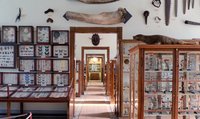Trinkgefäß in Form eines Schnabelschuhs aus zinnoberrotem Leder, dessen Spitze in einem Delfin aus Messing endet. Dieses ungewöhnliche Trinkgefäß wurde in Form eines Frauenschuhs in Leder und mit angenähter Sohle sowie kleinen Messingschellen-Füßchen gefertigt. Die vergoldete Messingkartusche zeigt ein noch ungedeutetes Wappen.
In der Linck-Sammlung befinden sich zwei weitere dieser Schuhe, deren ursprünglicher Gebrauch im 18. Jahrhundert schon nicht mehr bekannt war. Hier wurden die Schuhe im Gegenteil als "chinesische Frauenschuhe" bezeichnet. Zu vermuten ist deshalb, dass dieses Objekt erst spät in die Sammlung aufgenommen wurde.
Belegt im Linck-Index III. (1787), S. 104, No. 98: "Ein chinesischer Frauenschuh, welcher wegen seiner besondern Gestalt merkwürdig. Er ist mit vergoldeten Kupfer beschlagen und hat Schellen an den Sohlen."
en

